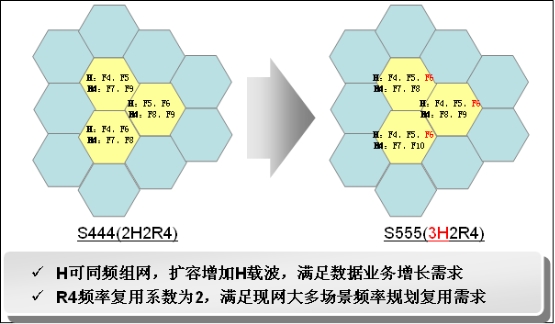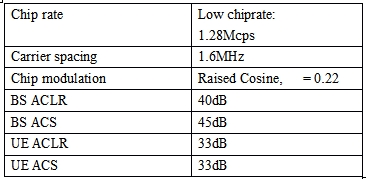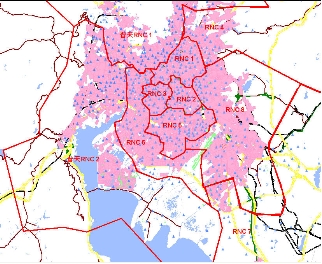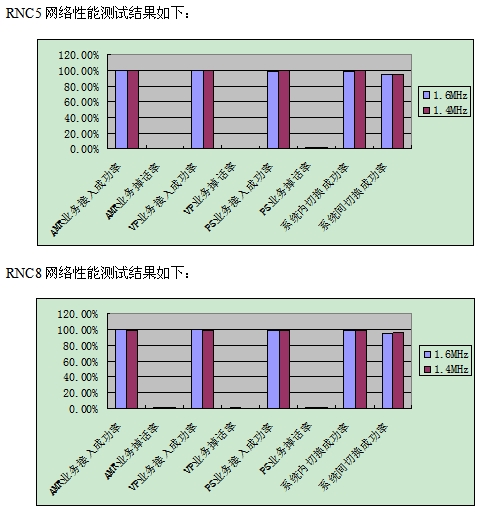With the rapid spread of TD-SCDMA network construction nationwide, how to further improve the capacity and quality of TD-SCDMA network and improve user experience is a matter of great concern to China Mobile. At present, the frequency band for large-scale commercial use of TD-SCDMA's current network is the A-band (2010-2025MHz), with a total of 9 available frequency points; due to PHS interference and other problems, the application of F-band 1800-1900MHz has not yet been launched on a large scale. As the number of TD users continues to increase and the volume of business continues to increase, the problem of tight frequency resources on the existing network is becoming increasingly prominent. In order to improve the performance of TD's existing network, Datang Mobile actively explored. Based on the research of TD-SCDMA standard and the analysis of equipment implementation, Datang Mobile worked with China Mobile Communications Group Design Institute Co., Ltd. to carry out the TD carrier interval compression scheme. Relevant theoretical analysis research and test verification, hope to contribute to improving the performance of TD-SCDMA network. After that, under the unified arrangement and deployment of China Mobile Group Corporation, Datang Mobile was the first to complete the pilot application test of the current network expansion in Kunming under the overall organization and coordination of Yunnan Mobile and Design Institute, which confirmed the TD-SCDMA carrier The interval compression scheme is feasible in the application of Datang Mobile's existing network. The 3G system stipulates that the channel rasterity is 200KHz, and the closest to 1.6MHz is 1.4MHz, so it may be considered to reduce the TD-SCDMA carrier spacing to 1.4MHz. In this way, a new frequency point can be added within the limited bandwidth of 2010-2025MHz to increase system capacity, which helps reduce network interference and improve network quality. But whether the TD-SCDMA carrier interval can be compressed, whether the existing network equipment can support the carrier interval compression scheme, and what impact will the carrier interval compression have on the existing network, these series of problems require in-depth research and verification to determine the carrier interval compression scheme Is it feasible. 1. Whether the TD-SCDMA carrier interval is compressible TD-SCDMA's normal download wave interval is 1.6MHz, but the carrier interval is not static. 3GPP 25.105 stipulates that the channel interval of 1.28Mcps TDD is 1.6MHz, but in some special networking scenarios, it can be adjusted to optimize performance. The specific regulations are as follows: • 5.4.1.2 1,28 Mcps TDD OpTIon 2. TD-SCDMA carrier interval compression scheme Compressing the TD-SCDMA carrier interval from 1.6MHz to 1.4MHz can increase the available frequency points within the existing bandwidth. At present, the A-band (2010-2025MHz) for large-scale applications on the existing network can be increased by 1 frequency point. Increased from 9 to 10. According to simulation analysis, the effect of carrier interval compression on 64QAM is relatively serious. Considering the outdoor situation, the probability of applying 64QAM is relatively small. Carrying out the 1.4MHz carrier interval configuration outdoors has little effect on capacity. It is recommended that this new frequency point be used for outdoor groups Network, indoor carrier spacing is still set to 1.6MHz. The outdoor application carrier is increased from 6 carrier to 7 carrier, and the frequency application can be flexibly configured according to the service development application when networking. The configuration as shown in the figure below, on the one hand, can effectively increase the R4 service frequency reuse factor of the existing network, reduce network co-channel interference, and improve network quality. On the other hand, the S444 configuration in most scenarios on the existing network can be expanded to S555, which is beneficial to the growth of TD data services. According to the current equipment implementation capabilities of Datang Mobile, after the carrier spacing is reduced to 1.4MHz, the existing network product hardware does not need any modification, and the RNC and OMC versions do not need any modification. Only the Node B software upgrade can support the 1.4MHz carrier spacing compression scheme. This solution is convenient and fast, and saves costs. 3. Analysis of problems caused by TD-SCDMA carrier interval compression The chip rate of TD-SCDMA is 1.28Mcps and the bandwidth is 1.6MHz. At present, the baseband shaping filter of TD-SCDMA equipment adopts RRC filter, and the filter roll-off coefficient is α = 0.22. Without modifying the existing equipment, after the carrier interval is compressed from 1.6MHz to 1.4MHz, the bandwidth required by the baseband filter with α = 0.22 cannot be met, which will affect the system's adjacent frequency leakage and adjacent frequency interference suppression performance, adjacent frequency interference There is a certain increase, which may not meet the requirements of coexistence of adjacent frequencies of multiple operators. In addition, if the adjacent channel interference increases to a certain degree, it will affect the network performance. With the introduction of HSPA / PA +, higher-order modulation is gradually introduced, which can effectively increase the data rate in the case of high C / I. When the carrier interval is compressed, adjacent-channel interference will have a certain impact on C / I. 1. The Effect of Carrier Interval Compression on Operators' Coexistence of Adjacent Frequency For multi-operator coexistence and co-location, adjacent-channel interference is mainly considered. Usually, adjacent-channel leakage at the transmitting end and adjacent-channel selectivity at the receiving end need to be considered. The measurement index is adjacent-channel interference suppression ACIR. According to the results of interference simulation between TDD systems in 3GPP 25.942 (V800), the ACIR uplink required for coexistence of adjacent frequencies in the worst environment is about 32.5dB, and the downlink is about 30.5dB. The determination of the TD-SCDMA system radio frequency index mainly takes into account the operator's need for ACIR for adjacent-frequency coexistence and the factors of equipment achievability. The basic radio frequency indicators of TD-SCDMA are as follows: According to the 3GPP simulation results, under the above radio frequency parameter definition, the capacity loss is basically negligible when different operators coexist in adjacent frequencies. When considering the interference between different frequencies within the same operator, the requirements for adjacent-channel interference can be appropriately relaxed. In this case, there is an optimization space for further narrowing the carrier interval. This situation was discussed at the beginning of the formulation of the 3G standard, and it was believed that the carrier spacing could be reduced within the same operator. Implementation into the specification also provides flexibility for this application. The specification specifies that the carrier spacing can be adjusted to optimize performance in some special networking scenarios. CCSA has also conducted a detailed study on the impact of adjacent-channel interference. According to the CCSA simulation conclusion, for the interference between different carriers of the same operator, when ACIR> 25dB, the capacity loss is very small. When the carrier interval is compressed, the radio frequency indicators of the base station and the terminal both deteriorate to a certain extent. If the system capacity is not significantly affected, carrier interval compression is feasible. According to Datang mobile device test results, after the carrier spacing is compressed to 1.4MHz, the device ACIR is greater than 25dB. This index cannot meet the requirement of co-existence of adjacent frequencies of multiple operators, but in the case of a single operator of China Mobile operating TD-SCDMA, it may be considered to optimize the carrier interval of TD-SCDMA. 2. Impact of Carrier Interval Compression on System Performance From the system simulation study, we can see that for 16QAM modulation, the C / I loss caused by carrier interval compression is about 0.5dB; for 64QAM modulation, the C / I loss caused by carrier interval compression is about 2dB. It can be seen that the impact of carrier interval compression on 64QAM is relatively serious. With the introduction of HSPA / PA + and the gradual introduction of higher-order modulation, the system performance will be affected to some extent after the carrier interval is compressed. Considering the outdoor situation, the probability of applying 64QAM is small, and the 1.4MHz carrier interval configuration outdoors has a great impact on capacity small. 4. Test and verification of TD-SCDMA carrier interval compression scheme In order to verify the feasibility of the 1.4MHz actual networking, Datang Mobile conducted the test verification in the company's internal system testing laboratory and Kunming's external field under real loading conditions. 1. Datang Mobile Communication Equipment Co., Ltd. System Testing Laboratory Test In order to verify the feasibility of the 1.4MHz carrier spacing application, at the end of June 2009, Datang Mobile conducted relevant test research in the laboratory and compared the carrier carrying capacity and HSDPA users of the TD-SCDMA carrier spacing of 1.4MHz and 1.6MHz. Throughput capabilities and basic functions such as power-on dwell delay and call connection, according to the indoor test results, there is no significant difference between the indicators under the two carrier spacings of 1.4MHz and 1.6MHz. 2. Yunnan Mobile Kunming TD-SCDMA network real load test In order to further verify the feasibility of the 1.4MHz actual networking, in August 2009, with the strong support of Yunnan Mobile, Datang Mobile conducted relevant tests under the real loading situation of the Kunming TD-SCDMA network. Indoor and outdoor, the performance of R4 and HSDPA, network KPI indicators and system capacity were tested and verified at 1.6MHz and 1.4MHz carrier intervals, respectively, comparing the performance of the same frequency and adjacent frequency interference in the cell before and after carrier interval compression Impact, and compare network indicators through KPI testing. Kunming indoor test site is Huidu International Building, which is a typical business office environment. The outdoor test was carried out in the prosperous area of ​​Chenggong County in southern Kunming. It involved 7 base stations, 10 cell coverage, and 6 main neighboring cells in the periphery. Through various test scenarios in Kunming for indoor and outdoor test scenarios, different test methods for fixed-point and drive tests, different test services for R4 and HSDPA, different indicators for upstream and downstream, etc., statistical results and analysis data prove After adjusting the carrier interval of the TD-SCDMA system to 1.4MHz, it will not affect the existing network indicators due to the increase of adjacent channel interference. It is completely feasible to adjust the carrier interval of the TD system to 1.4M in the application of the existing network. 3. Yunnan Mobile Kunming Existing Network Expands Pilot Application Test The preliminary verification of TD-SCDMA carrier interval compression technology is feasible through preliminary protocol analysis, theoretical research, and scale testing in Kunming's field. Under the unified arrangement of China Mobile Group Corporation, from November 2 to November 14, 2009, Datang Mobile took the lead in conducting a test of expanding the pilot application of the existing network in Kunming, Yunnan. This Kunming live network test is the first pilot work initiated by China Mobile Corporation. This pilot test mainly investigates the difference between the network KPI index after the 1.4MHz carrier spacing networking and the existing network 1.6MHz carrier spacing networking KPI. Further verify the feasibility of TD-SCDMA carrier compression scheme in the existing network. According to the test scenario selection requirements and the actual situation of the Kunming RNC zone, this test selected RNC5 and RNC8 as the pilot test areas, covering two typical scenarios of dense urban areas and general urban areas, respectively. RNC5 mainly covers dense urban areas, including 82 base stations and 209 cells; RNC8 mainly covers general urban areas, including 119 base stations and 346 cells. The schematic diagram of the selected area is as follows: According to the requirements of the pilot scenario, the network performances of RNC5 and RNC8 are counted and compared and analyzed. The current network statistics KPI indicators involve CS domain, PS domain services, and handover success rate. At the same time, statistics such as business volume and RAB establishment time are used as reference. The access success rate and call drop rate of the CS domain and PS domain services are separately counted, and the handover success rate within the system and the handover success rate between systems are separately counted for the handover success rate. According to the comparison of the comprehensive indicators of the two pilot RNCs, the average network load in the two scenarios is basically the same, the average network indicator and the service access delay (RAB establishment delay) are basically the same, the pilot RNC under the 1.4MHz carrier interval The KPI index is not worse than the network performance at 1.6MHz as a whole. A certain statistical time and a large number of existing network statistical data results again verify that the method of compressing the TD-SCDMA carrier interval and increasing the number of carriers is completely feasible in the application of the existing network. Through the above in-depth and meticulous research analysis and multiple test verifications, the TD-SCDMA carrier interval compression scheme is feasible in the existing network. In the current TD-SCDMA network construction phase, under the same frequency resource conditions, the reduced TD carrier spacing scheme provides more carrier numbers, which can increase system capacity, help reduce network interference, and quickly improve the TD network quality. The TD carrier interval compression method improves the spectrum utilization rate of wireless resources and will bring greater economic benefits. 3.5mm ribbon connectors are used to connect ribbon cables to audio and video devices such as headphones, speakers, microphones, and cameras. These connectors are commonly used in the electronics industry because they provide a secure and reliable connection. They are easy to install and remove, making them ideal for DIY projects or repairs. 3.5Mm Ribbon Connector,Bh3.5 Ribbon Connector,Ribbon Cable Adapter,Ribbon Wire Connectors YUEQING WEIMAI ELECTRONICS CO.,LTD , https://www.weimaicarconn.com
The channel spacing is 1.6MHz, but this can be adjusted to opTImise peRFormance in a parTIcular deployment scenario. 



3.5mm ribbon connectors are available in various configurations, including straight and right-angle versions, and can be used with different types of ribbon cables. They are also compatible with a wide range of audio and video devices, making them a versatile choice for many applications.
How to improve the capacity and quality of TD-SCDMA network
How to improve the capacity and quality of TD-SCDMA network